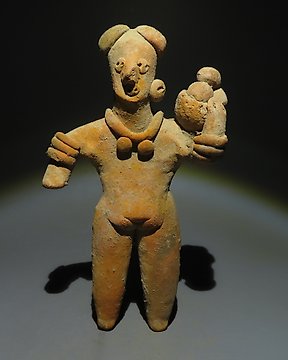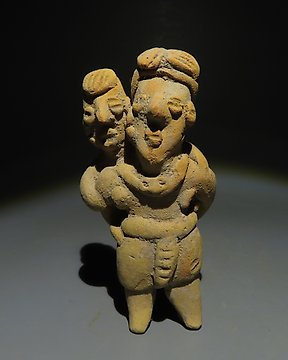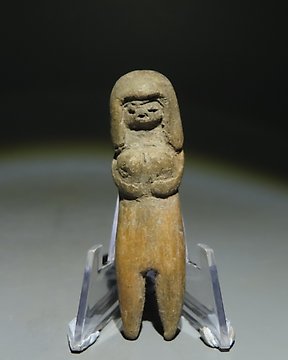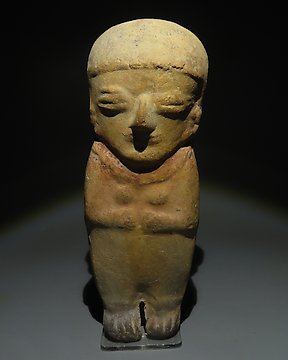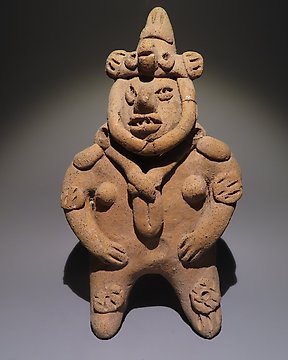El objeto decía estar en perfecto estado , intacto y en buena condición. Sin embargo estaba dañado y el silbato no funcionaba. Fue un engaño. Lamento la mala informacion
Vertaling bekijkenAzteken Terracotta Zegel. 1250-1521 n.Chr. 3cm hoogte. Spaanse importvergunning.
Nr. 84726563



Seal with the original pigment
Azteca.
1250-1521 AD.
Terracotta and the original pigment of the seal
3 cm height.
PROVENANCE: Romy Rey private collection, London, United Kingdom. 1980.
CONDITION: Good condition.
DESCRIPTION:
The Aztec or Mexica civilization inhabited the central high plateau of what is now Mexico, founding their capital Tenochtiltlán on the shores of Lake Texcoco, the location that was best suited to a large settlement owing to the availability of water, flora, and fauna. During this civilization’s imperial period it extended throughout much of the central Mexican region from the Atlantic to the Pacific coasts.
According to its own history, the Aztec culture, which developed during the Post Classical period of Mesoamerican history, originated in a barbarian hunter-gatherer group called the Chichimecas (which means breed of dogs) that emigrated from Aztlán and took up residence on an island in Lake Texcoco. The group expelled the Tepenecas in the year 1370 CE and founded the city of Tenochtitlán on the site where an eagle had devoured a serpent. They formed a triple alliance with other groups that lasted until the Aztecs grew independent and began their expansion. In 1519, when the empire was under the rule of Moctezuma II, the Spanish conquistadors arrived under the leadership of Hernán Cortés. Taking advantage of the enmity between the Aztecs and neighboring cultures, the Spanish defeated the Aztecs in a short time. Tolteca and Teotihuacana influences are believed to have made their mark on Aztec art and architecture.
The Aztecs had a clearly defined style based on religious symbolism. Their renowned stonework includes temple sculptures, mainly representing gods, and relief works, which often depicted leaders and were commissioned to commemorate important events. Another notable example of Aztec art was the Aztec Calendar, with a 365-day year and 52-year cycle. Little remains of the civilization’s wall murals, but extant historical accounts describe the culture’s history, imperial times, and myths. These accounts are given in ideographic script, with each symbol representing an idea. On a smaller-scale, the Aztec produced wooden funeral masks encrusted with turquoise, obsidian, or mother-of-pearl, as well as skulls carved from rock crystal. The Aztecs worked gold and silver to make necklaces, bracelets, and other personal jewelry, as well as statues of their gods. They also produced featherwork for such items as ceremonial vestments, capes, and shields displaying emblems of rank and power.
Notes:
- The piece includes authenticity certificate.
- The piece includes Spanish Export License.
- The seller guarantees that he acquired this piece according to all national and international laws related to the ownership of cultural property. Provenance statement seen by Catawiki.
De verkoper stelt zich voor
Seal with the original pigment
Azteca.
1250-1521 AD.
Terracotta and the original pigment of the seal
3 cm height.
PROVENANCE: Romy Rey private collection, London, United Kingdom. 1980.
CONDITION: Good condition.
DESCRIPTION:
The Aztec or Mexica civilization inhabited the central high plateau of what is now Mexico, founding their capital Tenochtiltlán on the shores of Lake Texcoco, the location that was best suited to a large settlement owing to the availability of water, flora, and fauna. During this civilization’s imperial period it extended throughout much of the central Mexican region from the Atlantic to the Pacific coasts.
According to its own history, the Aztec culture, which developed during the Post Classical period of Mesoamerican history, originated in a barbarian hunter-gatherer group called the Chichimecas (which means breed of dogs) that emigrated from Aztlán and took up residence on an island in Lake Texcoco. The group expelled the Tepenecas in the year 1370 CE and founded the city of Tenochtitlán on the site where an eagle had devoured a serpent. They formed a triple alliance with other groups that lasted until the Aztecs grew independent and began their expansion. In 1519, when the empire was under the rule of Moctezuma II, the Spanish conquistadors arrived under the leadership of Hernán Cortés. Taking advantage of the enmity between the Aztecs and neighboring cultures, the Spanish defeated the Aztecs in a short time. Tolteca and Teotihuacana influences are believed to have made their mark on Aztec art and architecture.
The Aztecs had a clearly defined style based on religious symbolism. Their renowned stonework includes temple sculptures, mainly representing gods, and relief works, which often depicted leaders and were commissioned to commemorate important events. Another notable example of Aztec art was the Aztec Calendar, with a 365-day year and 52-year cycle. Little remains of the civilization’s wall murals, but extant historical accounts describe the culture’s history, imperial times, and myths. These accounts are given in ideographic script, with each symbol representing an idea. On a smaller-scale, the Aztec produced wooden funeral masks encrusted with turquoise, obsidian, or mother-of-pearl, as well as skulls carved from rock crystal. The Aztecs worked gold and silver to make necklaces, bracelets, and other personal jewelry, as well as statues of their gods. They also produced featherwork for such items as ceremonial vestments, capes, and shields displaying emblems of rank and power.
Notes:
- The piece includes authenticity certificate.
- The piece includes Spanish Export License.
- The seller guarantees that he acquired this piece according to all national and international laws related to the ownership of cultural property. Provenance statement seen by Catawiki.
De verkoper stelt zich voor
- 752
- 7
- 1
Fast delivery, object fine. However, bad carrier: please never use again DHL express as they are "DHL slow": instead of coming to my address, they put it directly to a DHL Service Point/Locker.
Vertaling bekijkenTodo correcto
Vertaling bekijkenI am very happy with the ancient bronze horse. Excellent that it was delivered within a few days. My compliments to J.Bagot Arqueologia- Ancient Art, well done! Ron van Schaick
Vertaling bekijkenPerfect transaction and fantastic item. Thank you.
Vertaling bekijkenconforme rapide hope other thanks ++++
Vertaling bekijkenKülönleges eszköz, jó állapotban van, köszönöm a rendkívül gyors szállítást. Ajánlom az Eladót!
Vertaling bekijkenfast delivery, good packaging
Vertaling bekijkenGood seller: fast shipment, good packing and a very nice object. Thank you!
Vertaling bekijkensuper 💯💯💯💯💯
Vertaling bekijkenIl pezzo è arrivato in condizioni perfette il pacco era protetto alla perfezione
Vertaling bekijkenBuenos días, señor. ¡Gracias por las precauciones de embalaje Tip / Top! Muy contento con mi compra. ¡Gracias!
Vertaling bekijkenPerfecto! :)
Vertaling bekijkenWunderbares Stück. Alles wie beschrieben. Hervorragender Kontakt.
Vertaling bekijkenExtremely rapid courrier service from Barcelona to Flanders, picture was nicely and carefully packaged. Muchas gracias!
Vertaling bekijkenVery fine specimen! Thanks.
Vertaling bekijkengoede foto's, goede omschrijving, goed verpakt en snel verzonden.
Vertaling bekijkenmolto bello tutto ok
Vertaling bekijkenPezzo come da descrizione, davvero notevole. Venditore molto consigliato in quanto gentile e disponibile. spedizione molto veloce. Ottimo!
Vertaling bekijkenVenditore davvero ottimo e gentile. Merce come da descrizione, spedizione veloce. Ottimo l'avere certificato di autenticità.
Vertaling bekijkenUn 100 como empresa un 100 como envío . Empresa muy especial con mucha exquisitez en todos los productos y en personal . Muchas gracias
Vertaling bekijkenAll well! Thanks.
Vertaling bekijkenVery nice and fine cut little jewel! Well packed too! Thanks!
Vertaling bekijkennice piece and very fast shipping!
Vertaling bekijken- 752
- 7
- 1
El objeto decía estar en perfecto estado , intacto y en buena condición. Sin embargo estaba dañado y el silbato no funcionaba. Fue un engaño. Lamento la mala informacion
Vertaling bekijkenDisclaimer
De verkoper garandeert dat het object legaal is verkregen en kan dit bewijzen. Catawiki heeft de verkoper geïnformeerd dat hij/zij documentatie moet overleggen die vereist is volgens de wetten in hun land van verblijf. De verkoper garandeert dat hij/zij toestemming heeft om het object te verkopen/exporteren. De verkoper zal alle over het object bekende herkomstgegevens aan de koper verstrekken. De verkoper zorgt ervoor dat eventueel benodigde vergunningen zijn/zullen worden geregeld. De verkoper zal de koper onmiddellijk informeren over eventuele vertragingen bij het verkrijgen van dergelijke vergunningen.
De verkoper garandeert dat het object legaal is verkregen en kan dit bewijzen. Catawiki heeft de verkoper geïnformeerd dat hij/zij documentatie moet overleggen die vereist is volgens de wetten in hun land van verblijf. De verkoper garandeert dat hij/zij toestemming heeft om het object te verkopen/exporteren. De verkoper zal alle over het object bekende herkomstgegevens aan de koper verstrekken. De verkoper zorgt ervoor dat eventueel benodigde vergunningen zijn/zullen worden geregeld. De verkoper zal de koper onmiddellijk informeren over eventuele vertragingen bij het verkrijgen van dergelijke vergunningen.
